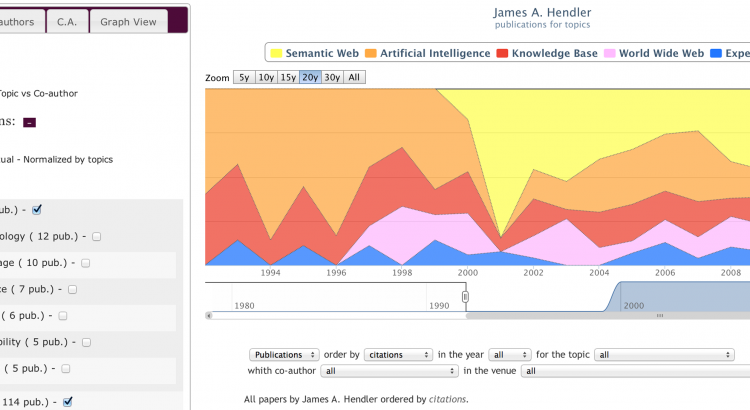Rexplore leverages novel solutions in large-scale data mining, semantic technologies and visual analytics, to provide an innovative environment for exploring and making sense of scholarly data. In particular, Rexplore allows users:
- To detect and make sense of important trends in research, such as, significant migrations of researchers from one area to another, the emergence of new topics, the evolution of communities within a particular area, and several others.
- To identify a variety of interesting relations between researchers, e.g., recognizing authors who share similar research trajectories. These relations go well beyond the standard co-authorship links or relationships informed by social networks, which are commonly found in other systems.
- To perform fine-grained expert search with respect to detailed multi-dimensional parameters.
- To analyse research performance at different levels of abstraction, including individual researchers, organizations, countries, and research communities identified on the basis of dynamic criteria.
An important aspect of Rexplore is that it does not rely on manually-generated taxonomies of research areas, which tend to be shallow and date very rapidly, but uses instead an innovative ontology population algorithm, Klink, which automatically constructs a semantic network of fine-grained research areas, linked by semantic relations, such as sameAs and subAreaOf. The use of Klink ensures a fine-grained handling of research areas and affords Rexplore a very high level of precision and recall in associating topics to publications and researchers.
Rexplore integrates a variety of data sources in different formats, including both major bibliographic repositories, as well as other resources, such as DBpedia and GeoNames. As of December 2013, Rexplore integrates metadata on 20 million papers, 2 million authors and about 3000 topics.
Rexplore offers an advanced graphical interface, comprising a variety of innovative and fine grained visualizations, which support users in exploring authors, topics, and research communities. To support effective exploration, all graphical elements can be clicked on, thus enabling a seamless and contextualized navigation. In the above gallery we show a few snapshots of the system in action.
Official Web Site: http://technologies.kmi.open.ac.uk/rexplore/



